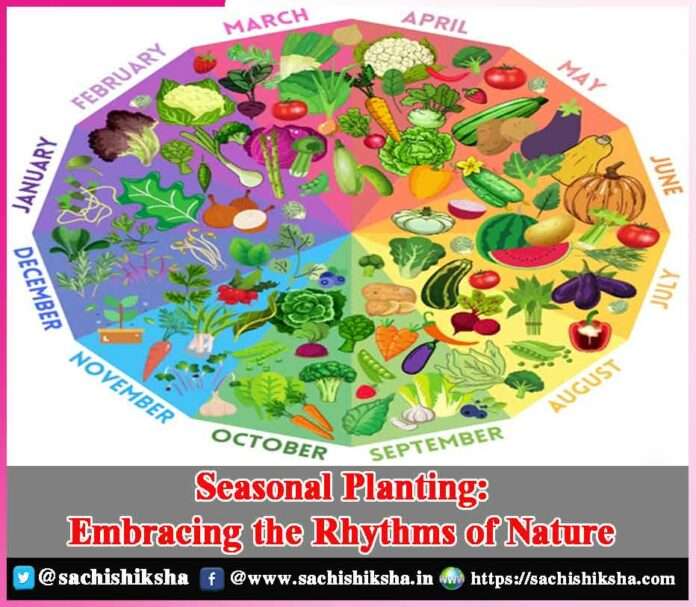Seasonal Planting: Embracing the Rhythms of Nature
Introduction: In today’s fast-paced world, where technology and urbanization dominate, it is easy to lose touch with the natural world around us. However, there is a growing movement to reconnect with nature and its rhythms, and one beautiful way to do this is through seasonal planting. Embracing nature’s cycles and adapting our gardening practices to match the changing seasons not only benefits the environment but also enhances our well-being and yields abundant rewards. In this article, we will explore the significance of seasonal planting and how it can positively impact our lives.
Also Read:-
- Food Security
- Basics of Stock Market
- Food Security in India
- Integrated Farming System
- Scientific Cultivation of Lady Finger
- Utilize Waste Things
Table of Contents
Understanding Seasonal Planting:
Seasonal planting is the art of cultivating and sowing crops according to the natural cycles of the climate and environment. This traditional practice follows the natural rhythm of the seasons, allowing plants to thrive in their ideal conditions. It is a stark contrast to modern agriculture, which often relies on artificial inputs and attempts to force crops to grow out of their natural time frames.
Importance of Seasonal Planting:
- Ecological Balance: Embracing seasonal planting promotes biodiversity and helps maintain ecological balance. Native plants are better adapted to the local climate, soil, and pests, which means they require fewer resources and chemical interventions to flourish. By supporting local flora and fauna, seasonal planting contributes to a healthier ecosystem.
- Conservation of Resources: Seasonal planting encourages the efficient use of resources like water and fertilizers. When crops are planted in their appropriate season, they tend to require less water and nutrients, reducing waste and promoting sustainable agriculture.
- Enhancing Soil Health: Different plants have varying nutrient needs, and seasonal planting helps to maintain the fertility of the soil. Rotating crops and allowing fields to lie fallow during certain seasons prevents soil depletion, preventing the need for excessive artificial inputs.
- Pest and Disease Management: Seasonal planting can be an effective natural method to manage pests and diseases. By rotating crops and planting diverse species, farmers can disrupt pest life cycles and reduce the risk of widespread infestations.
- Improved Flavour and Nutrition: Seasonal fruits and vegetables are often fresher and more flavourful since they are harvested at their peak ripeness. Additionally, seasonal produce tends to be higher in nutritional value compared to those grown out of season or transported over long distances.
Benefits for Gardeners and Farmers
- Reduced Effort and Costs: When plants are grown in their natural season, they are more likely to thrive with minimal intervention. Gardeners and farmers can save on labour, water, and inputs, making their practices more economically sustainable.
- Mental and Emotional Well-being: Seasonal planting can be therapeutic, providing a sense of connection with nature and a break from the fast-paced urban lifestyle. Working with the earth and witnessing the cycles of life can be deeply fulfilling and calming.
- Community and Culture: Seasonal planting fosters a sense of community and shared experiences. In many cultures, planting and harvesting are celebrated through festivals and rituals, strengthening social bonds and preserving traditions.
- Adaptation to Climate Change: As the effects of climate change become more pronounced, seasonal planting becomes vital in adapting to the shifting weather patterns. Native and well-adapted plants are more resilient and can withstand extreme weather events better.
How to Embrace Seasonal Planting:
- Learn Your Local Climate: Understand the specific characteristics of your local climate and its impact on plant growth. Familiarize yourself with the average frost dates, temperature ranges, and precipitation patterns.
- Choose Suitable Plants: Select the plants that are well-suited to your climate and soil type. Local nurseries and agricultural extension offices can offer valuable guidance on the best plants for each season.
- Create a Planting Calendar: Develop a planting calendar based on the ideal times for sowing seeds and transplanting seedlings. This calendar should consider the first and the last frost dates and the recommended planting windows for different crops.
- Practise Crop Rotation: Rotate crops each season to prevent soil depletion and reduce the risk of pests and diseases. Certain plants also improve soil health by fixing nitrogen or breaking up compacted soil.
- Compost and Mulch: Build healthy soil by composting kitchen scraps and yard waste. Use mulch to retain soil moisture, suppress weeds, and regulate soil temperature.
Conclusion: Seasonal planting is a beautiful way to harmonize our lives with the natural world, reaping numerous environmental, economic, and emotional benefits. By embracing nature’s rhythms and planting in sync with the seasons, we can enhance biodiversity, conserve resources, and foster a deeper connection with the earth. Whether you have a small garden or a vast farmland, seasonal planting offers a sustainable and rewarding approach to gardening and farming. Let us embrace the wisdom of nature and cultivate a greener, healthier future through seasonal planting.

















































